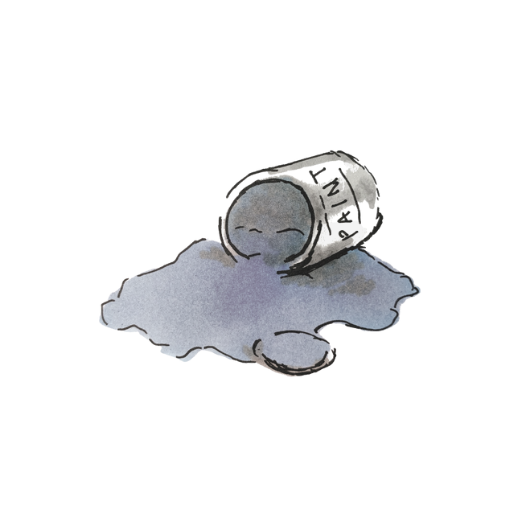
Why would you want to? I hear you ask
Because mirrors are really bloody expensive! My bathroom mirror is 60cm x 96cm and it cost a whopping £15 from IKEA. Now, a mirror that size, complete with frame, could easily set you back a couple of hundred quid. Can I afford that right now? Nope! This guide to making an architrave mirror frame solves the problem and best of all it is beginner-friendly, quick and cheap. Win win win!

I totally transformed my mirror with a bit of architrave and beading. However, I managed to mess up my cuts not once, but twice (more about that later) so it took longer to make than anticipated (due to the repairs) but I will selflessly detail all my rookie errors so that you need not repeat them.
What you need for a DIY architrave mirror frame:
- Architrave – style is totally up to you. Must measure how much you need first. For my mirror I needed two standard lengths of this architrave and got a long edge cut and short edge cut off each. The architrave will sit around the edge of the mirror.
- Beading – this sits on top of the glass, inside the architrave. Again, be sure to measure so you get enough.
- Mitre box and saw
- No More Nails
- Decorator’s Caulk
- Paint
- Primer (I just use bog standard white emulsion as a primer)
- Tape measure
- Pencil
- J-Cloth
- An afternoon
How to use this guide
Throughout this guide, I will use these slash symbols: \ and / to illustrate the direction of the cut I am referring to. The cuts are all made at 45 degree angles.
Measuring correctly
Measuring correctly is key. You will be cutting at 45 degree angles and therefore it can be useful to have a diagram to refer to; you might sometimes need to cut upside down for example. It’s handy to draw the frame out first to understand what to measure and where to cut.

When cutting a frame like this, it’s crucial to get the measurements right. As the architrave frame sits outside the mirror edge, it is the inside of the frame that lines up with the mirror. You can see from looking at the diagram that the inside of the frame is shorter than the outside, due to the angles: \ /
Cutting the frame
It is really important that you cut the first angle like this \ and then measure the length of the mirror from the bottom left point.
This was actually my first rookie error: I cut the angle correctly and took into consideration the need to ensure the bottom (not the top!) of the frame, which was 60cm (being the width of the mirror). However, when I came to measure my length of architrave from the bottom of my \ cut, I misplaced the tape measure, positioning it in the middle of the wood. As a result, I cut a length about a cm too short. It’s actually easier to measure with a flat ruler or dressmakers tape .
In short, be sure to measure from the bottom left corner (where the nib of my pencil is shown below).

Use a mitre box to cut your lengths of wood. I use this one*. It’s incredibly easy to use. It is not the flashiest bit of kit, but it does the job for small projects like this and is reasonably priced. It also comes with a small hand saw which I found useful.
Plan your cuts carefully
Keep referring to your diagram to be sure you’re cutting the right lengths and remember to calculate how many lengths you can cut from one standard piece of architrave to avoid the need to buy extra.
Oh, here’s rookie mistake number 2! Having cut my first 60cm length, I began cutting the second 60cm length from the same piece of architrave. If I had done this, I would not have been able to get two full longer lengths of 96cm from the second piece of architrave (as the standard length architrave is too short to allow for this). I needed to cut one long length and one short length from each piece of architrave.
Moral of the story: Plan Ahead.

Attaching the architrave mirror frame
Once you have cut your architrave mirror frame lengths, you are on the home stretch.
I stuck mine directly to the wall using No More Nails. Do keep in mind that if you do this, you are committing to the mirror staying in that position basically forever.
If you want to be able to move the mirror, then I would suggest getting a backing sheet of MDF cut to size (you can usually get this done for you at the DIY shop). It will need to be cut to include an overhang where you will stick the frame around the mirror. You can then hang it. I didn’t do this, so I don’t have pictures, but I have previously stuck mirror to MDF using No More Nails and it works fine.

Apply the No More Nails as illustrated in a wavy line. Line up the corners of the frame and mirror and firm the frame into place with a wiggle. Hold firm against the wall for at least 30 seconds to ensure good adhesion.
Fill the gaps
I used fine filler (caulk would work too) to fill in the small gaps where the frame panels meet each other. Once dry, I buffed the filler with a fine sanding sponge to make it really smooth.

Applying beading
The mirror is attached to the wall using little brackets, which you can see in the picture above. I didn’t want these to be visible, so I decided to add beading inside the mirror frame, stuck directly onto the mirror.
The beading is cut in the same way, using the mitre box. However, this time, the outer edge of the beading lines up with the edge of the mirror.

When you measure your lengths and begin cutting, keep this in mind as it is the opposite of the frame.
You may prefer to paint the beading before sticking it on using No More Nails. This is because it does create a reflection against the mirror.
Caulking
Allow the No More Nails 24 hours to dry before moving onto this step.
Around the architrave mirror frame
Caulk needs to be applied around the edge of the architrave mirror frame where it meets the wall; this is just to give a tidy finish.
Between architrave mirror frame and beading
This is important because it hides the metal brackets. You may need to apply a couple of layers of caulk, letting each dry before the next application.
Around beading and mirror

This is fiddliest of all. The beading reflects onto the glass, so to finish the frame nicely, caulk is needed in the gap between the beading and the mirror glass.
Apply a thin line of caulk and smooth into position with your finger. I then used a J-Cloth to remove any excess from the mirror itself. I applied the caulk a couple of times to get the finish I wanted and although it is a bit tricky to get the hang of, it is worth persevering for a really tidy finish.
Painting the architrave mirror frame
Finally, it is time to paint! I used white emulsion to prime the wood (I never bother with specialist primers as I think they are a total waste of money and the whole point of this project was to make a frame on the cheap!).
I used a few coats of water-based, quick-drying white satin paint.


Like this blog? Pin for later:

Sign up to the mailing list!
Get blog notifications, DIY guides, exclusive offers and all the latest interiors chat direct to your inbox. Subscribe today!


Such a great post Mel. Super crafty! Nessie xxx